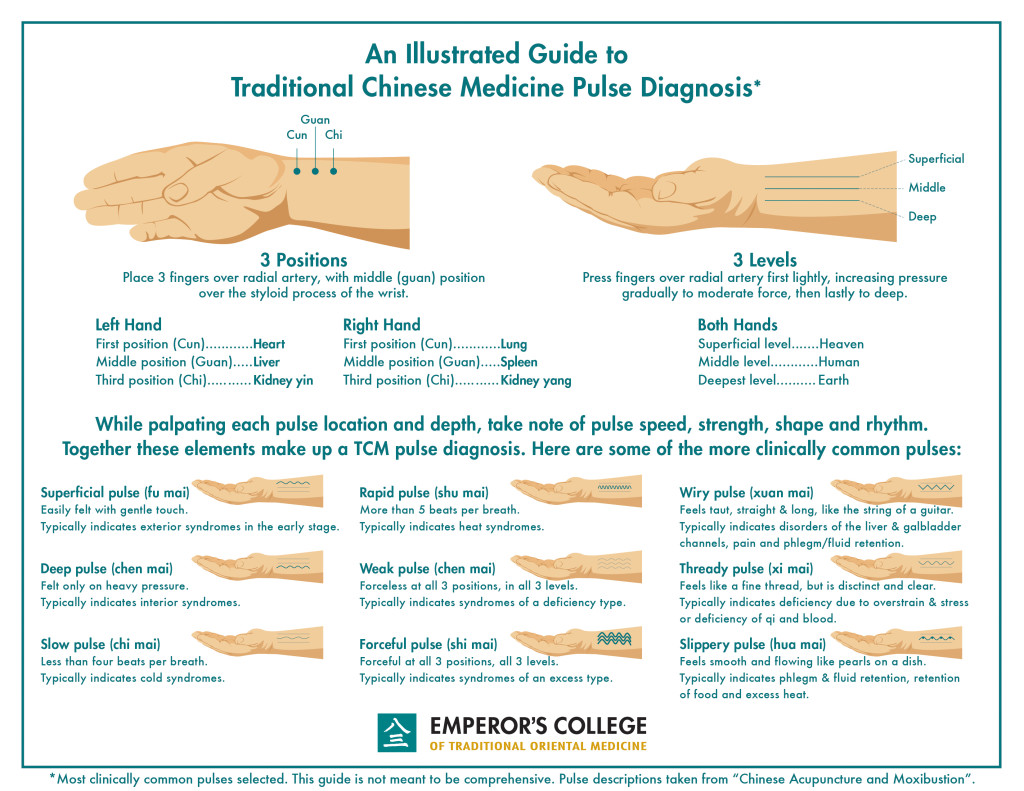In both Eastern and Western medicine, a patient’s pulse plays an important role because it is a valuable indicator of their well-being. We’ve all been to Western doctors who checked our pulse rates as one method of determining heart health. A normal rate is considered to be between 60-90 beats per minute and a rate that is considerably faster or slower may signal a problem.
In Chinese Medicine pulse diagnosis is also a very important diagnostic tool that provides your practitioner with information about the state of your health but in different ways. Chinese Medicine pulse diagnosis is a more detailed and subtle process; we are looking for much more than your pulse rate.
Why is pulse diagnosis such a large part of traditional Chinese medicine (TCM)? Because thousands of years ago when Chinese medicine theories began to develop, there were no x-rays or MRIs available to produce pictures of the insides of our bodies. Therefore, in their wisdom, the ancient Chinese doctors created external methods designed to understand the body’s interior, including: observation; careful questioning; tongue diagnosis; and pulse diagnosis. Today we’re focusing on the pulse.
The basics of Chinese pulse diagnosis
Chinese pulse diagnosis is complex but let’s begin with some of the basics. When I take your pulse, I place three fingers over the radial artery in your wrist. Each of my fingers rests on a different section of the pulse: front; middle; and rear. Each section correlates with different organs. I feel for the pulse rate, but my fingers also search for pulse length, depth and quality because these pulse attributes are equally important. When I put all this information together, I learn more about your wellness.

Pulse length: Pulse length is thought of as shorter vs. longer and provides indications of the strength and balance of blood and energy flow. All three fingers resting on your artery feel for pulse length. If the pulse is not felt under all 3 fingers, it is considered shorter; if the pulse exceeds the 3 fingers it is considered to be longer. A longer pulse could be normal if there are no other disquieting signs, but if a pulse is a combination of short and weak, it means that the energy is not strong enough to move your blood. In contrast, a short and forceful pulse would reflect more of a stagnant condition, of blood not flowing well because there are blockages.
Pulse depth: When I feel for the depth of the pulse, at first I apply almost no pressure at the superficial level, a bit more to the middle level, and the most pressure to the deep level to determine where the pulse is felt. The depth of the pulse reflects the level of Qi in the body and indicates the type of pathological condition that might be present. For example: a pulse felt at the more superficial level is often indicative of an exterior illness, like a cold or flu, whereas a deep pulse reflects the state of the organs and more internal conditions.
Pulse quality: Another way to think of pulse quality is to imagine that your pulse has texture. In TCM, there are 28 different pulse qualities. Two common examples of texture or quality include: choppy, a rougher pulse with an uneven flow, and slippery, a pulse that feels like little ripples or beads are running underneath my fingers.
Examples of different pulses
When your practitioner gathers all this pulse information, and there are hundreds of variations, she assembles it in order to understand the condition of your body. Let me provide an example that incorporates the different pulses I have explained: a patient has a slower pulse (rate) that I feel at a deep level (depth) and it is slippery (quality). This indicates a condition of interior dampness with cold in the body. Contrast this patient with another person who has a rapid (rate), floating (depth) pulse that signifies an exterior heat condition such as a cold with a sore throat.
This pulse information, and much more, helps your practitioner choose the most appropriate acupuncture points, herbal formula and form a treatment plan and that will best suit your body’s needs.
Take your own pulse
There are many TCM practices that I advise people to practice at home but detailed pulse taking is not one of them. If you would like to test something simpler in order to understand your pulses better, take your own pulse and compare it to a friend’s to see what differences you are able to feel. Or, the next time you are coming down with a cold, rest three fingers ever so lightly on your wrist to see if you feel a more superficial pulse than usual. Don’t be disappointed if you only feel a gentle beat; pulse taking is an art that has been studied for many years and even those of us who have been trained in pulse taking, are constantly refining our skills.
(Courtesy of Jennifer Dubowsky, LAc and Emperor’s College of Traditional Oriental Medicine 2014)
Get us to feel your pulse and tell you what we think…
We are regularly at:
The Foreshore Market – Hastings Farmers and Artists Markets
Location: Westport Park Buller and Parks Streets, Port Macquarie, 2444
When: Second Saturday of each month from 8:00am-1:00pm.
The Artist Market in the Vines
Location: Cassegrain Winery, 764 Fernbank Creek Rd, Port Macquarie, NSW, 2444.
When: Fourth Sunday of each month from 9:00am-3:00pm.


